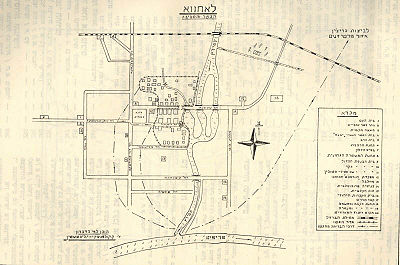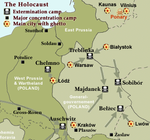
Łachwa Ghetto
Encyclopedia


Nazi Germany
Nazi Germany , also known as the Third Reich , but officially called German Reich from 1933 to 1943 and Greater German Reich from 26 June 1943 onward, is the name commonly used to refer to the state of Germany from 1933 to 1945, when it was a totalitarian dictatorship ruled by...
in the town of Łachwa in occupied Poland (now Lakhva
Lakhva
Lakhva is a small town in southern Belarus, with a population of approximately 2100. Lakhva is considered to have been the location of one of the first, and possibly the first, Jewish ghetto uprisings of the Second World War.-Geography:Lakhva is located in the Luninets district of the Brest...
, Belarus
Belarus
Belarus , officially the Republic of Belarus, is a landlocked country in Eastern Europe, bordered clockwise by Russia to the northeast, Ukraine to the south, Poland to the west, and Lithuania and Latvia to the northwest. Its capital is Minsk; other major cities include Brest, Grodno , Gomel ,...
), with the aim of persecution, terror and exploitation of the local Jews
History of the Jews in Poland
The history of the Jews in Poland dates back over a millennium. For centuries, Poland was home to the largest and most significant Jewish community in the world. Poland was the centre of Jewish culture thanks to a long period of statutory religious tolerance and social autonomy. This ended with the...
. The ghetto
Ghetto
A ghetto is a section of a city predominantly occupied by a group who live there, especially because of social, economic, or legal issues.The term was originally used in Venice to describe the area where Jews were compelled to live. The term now refers to an overcrowded urban area often associated...
existed only until September. It was the location of one of the first, and possibly the first, Jewish ghetto uprising
Ghetto uprising
Ghetto uprisings were armed revolts by Jews and other groups incarcerated in ghettos in Nazi-occupied Europes during World War II against the plans to deport the inhabitants to concentration and extermination camps....
after the Nazi–Soviet Invasion of Poland.
Establishment of the ghetto
The German armyWehrmacht
The Wehrmacht – from , to defend and , the might/power) were the unified armed forces of Nazi Germany from 1935 to 1945. It consisted of the Heer , the Kriegsmarine and the Luftwaffe .-Origin and use of the term:...
entered the Soviet occupation zone
Soviet occupation of Poland
Soviet occupation of Poland can refer to*Period from 1939 to 1941 - see Occupation of East Poland by Soviet Union*Period from 1945-1989 - see Northern Group of Forces...
on June 22, 1941 under the codename Operation Barbarossa
Operation Barbarossa
Operation Barbarossa was the code name for Germany's invasion of the Soviet Union during World War II that began on 22 June 1941. Over 4.5 million troops of the Axis powers invaded the USSR along a front., the largest invasion in the history of warfare...
and two weeks later, on July 8, 1941, overran the town of Łachwa, located in the Polesie Voivodeship
Polesie Voivodeship
Polesie Voivodeship was an administrative unit of interwar Poland . It ceased to exist in September 1939, following German and Soviet aggression on Poland .-Population:...
of the Second Polish Republic
Second Polish Republic
The Second Polish Republic, Second Commonwealth of Poland or interwar Poland refers to Poland between the two world wars; a period in Polish history in which Poland was restored as an independent state. Officially known as the Republic of Poland or the Commonwealth of Poland , the Polish state was...
before 1939. Many young Jews escaped with the Red Army. A Judenrat
Judenrat
Judenräte were administrative bodies during the Second World War that the Germans required Jews to form in the German occupied territory of Poland, and later in the occupied territories of the Soviet Union It is the overall term for the enforcement bodies established by the Nazi occupiers to...
was established, headed by a former Zionist
Zionism
Zionism is a Jewish political movement that, in its broadest sense, has supported the self-determination of the Jewish people in a sovereign Jewish national homeland. Since the establishment of the State of Israel, the Zionist movement continues primarily to advocate on behalf of the Jewish state...
leader, Dov Lopatyn
Dov Lopatyn
Dov Lopatyn was the head of the Judenrat in Łachwa, Poland in 1941-1942. He refused the demand of the Einsatzgruppen that the Lakhva Ghetto inhabitants line up for deportation, and on September 3, 1942, he led one of the first ghetto uprisings of the war.More than half of the ghetto population was...
. Rabbi Hayyim Zalman Osherowitz was arrested by the Germans, and his release was secured only after the payment of a large ransom.
On April 1, 1942, the town's Jews were forcibly moved into a new ghetto consisting of two streets and 45 houses surrounded by a barbed wire fence. The ghetto housed roughly 2,350 people, which amounted to approximately 1 square meter for every resident.
Development of resistance
The news of massacres, committed throughout the region by German Einsatzkommandos, soon spread to Łachwa. The Jewish youth organized an undergroundUnderground resistance
Underground resistance may refer to*Underground Resistance , a musical collective from Detroit, Michigan*Underground resistance during World War II, the inhabitants of various locales resisting the rule of the Nazis, the Empire of Japan, and Mussolini...
under the leadership of Isaac Rochczyn (also spelled Yitzhak Rochzyn or Icchak Rokchin), the head of the local Betar
Betar
The Betar Movement is a Revisionist Zionist youth movement founded in 1923 in Riga, Latvia, by Vladimir Jabotinsky. It has been traditionally linked to the original Herut and then Likud political parties of Israel, and was closely affiliated with the pre-Israel Revisionist Zionist splinter group...
group. With the assistance of Judenrat, the underground managed to stockpile axes, knives, and iron bars, although efforts to secure firearms were largely unsuccessful.
By August 1942, the Jews in Łachwa knew that the nearby ghettos in Łuniniec (Luninets) and Mikaszewicze (now Mikashevichy, Belarus) had been liquidated. On September 2, 1942, the local populace were informed that some farmers, summoned by the Nazis, were ordered to dig large pits just outside the town. Later that day, 150 German soldiers from an Einsatzgruppe
Einsatzgruppen
Einsatzgruppen were SS paramilitary death squads that were responsible for mass killings, typically by shooting, of Jews in particular, but also significant numbers of other population groups and political categories...
mobile killing squad with 200 local auxiliaries
Belarusian Auxiliary Police
Belarusian Auxiliary Police, later renamed Ordnungsdienst , was established in July 1941. It was staffed by local inhabitants and had similar functions to those of the Ordnungspolizei - OrPo - German Police. The OD activities were supervised by defense police departments, local commandant's...
surrounded the ghetto. Rochczyn, and the underground, wanted to attack the ghetto fence at midnight to allow the population to flee, but others refused to abandon the elderly and children. Lopatyn asked that the attack be postponed until the morning.
Uprising and massacre
On September 3, 1942, the Germans informed Dov Lopatyn that the ghetto was to be liquidated, and ordered, that the ghetto inhabitants gather for "deportation". To secure the cooperation of the ghetto's leaders, the Germans promised that the members of Judenrat, the ghetto doctor and 30 labourers (whom Lopatyn could choose personally) would be spared. Lopatyn refused the offer, reportedly responding: "Either we all live, or we all die."When the Germans entered the ghetto, Lopatyn set fire to the Judenrat headquarters, which was the signal to commence the uprising. Other buildings were also set on fire, and members of the Ghetto underground attacked the Germans as they entered the ghetto, using axes, sticks, molotov cocktail
Molotov cocktail
The Molotov cocktail, also known as the petrol bomb, gasoline bomb, Molotov bomb, fire bottle, fire bomb, or simply Molotov, is a generic name used for a variety of improvised incendiary weapons...
s and their bare hands. This battle is believed to represent the first ghetto uprising
Ghetto uprising
Ghetto uprisings were armed revolts by Jews and other groups incarcerated in ghettos in Nazi-occupied Europes during World War II against the plans to deport the inhabitants to concentration and extermination camps....
of the war.
Approximately 650 Jews were killed in the fighting or in the flames, and another 500 or so Jews were taken to the pits and shot. Six German soldiers and eight German and Ukrainian (or Belarusian) policemen were also killed. The ghetto fence was breached, and approximately 1,000 Jews were able to escape, of whom about 600 were able to take refuge in the Prypeć (Pripet) Marshes
Pinsk Marshes
The Pinsk Marshes or Pripyat Marshes are a vast territory of wetlands along the Pripyat River and its tributaries from Brest, Belarus to Mogilev and Kiev ....
. Rochczyn was shot and killed as he jumped into the Smierc River. Although an estimated 120 of the escapees were able to join partisan
Partisan (military)
A partisan is a member of an irregular military force formed to oppose control of an area by a foreign power or by an army of occupation by some kind of insurgent activity...
units, most of the others were eventually tracked down and killed. Approximately 90 residents of the ghetto survived the war. Dov Lopatyn joined a communist partisan unit, and was killed on February 21, 1944 by a landmine. Lakhva was liberated by the Red Army
Red Army
The Workers' and Peasants' Red Army started out as the Soviet Union's revolutionary communist combat groups during the Russian Civil War of 1918-1922. It grew into the national army of the Soviet Union. By the 1930s the Red Army was among the largest armies in history.The "Red Army" name refers to...
in July 1944.

